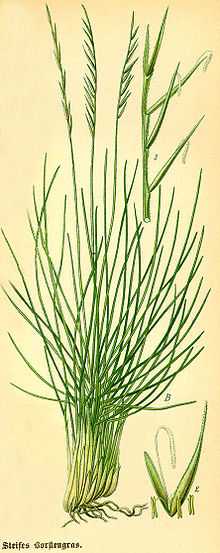Nardus
| matgrass | |
|---|---|
 | |
| Nardus stricta[1] | |
| Scientific classification | |
| Kingdom: | Plantae |
| (unranked): | Angiosperms |
| (unranked): | Monocots |
| (unranked): | Commelinids |
| Order: | Poales |
| Family: | Poaceae |
| Subfamily: | Pooideae |
| Tribe: | Nardeae |
| Genus: | Nardus L. |
| Binomial name | |
| Nardus stricta[2] L. | |
| Synonyms[3][4] | |
| |
Nardus is a genus of plants belonging to the grass family.[5]
The name derives from the Nardos (ναρδοσ), the ancient Greek name for this plant. It is not to be confused with Spikenard, Nardostachys grandiflora.
- Species
The only recognized species is matgrass, Nardus stricta.[6] It is native to Eurasia (from Iceland and the Azores to Mongolia), North Africa (Algeria, Morocco), and northeastern North America (Greenland, eastern Canada, and the northeastern United States).[3][7]
- formerly included[3]
see Ctenium Digitaria Eremochloa Microchloa Parapholis Psilurus
- Nardus aristata - Psilurus incurvus
- Nardus articulata - Parapholis incurva
- Nardus ciliaris - Eremochloa ciliaris
- Nardus dactyloides - Digitaria insularis
- Nardus gangitis - Ctenium aromaticum
- Nardus incurva - Psilurus incurvus
- Nardus indica - Microchloa indica
- Nardus monandra - Psilurus incurvus
- Nardus scorpioides - Ctenium aromaticum
- Nardus thomaea - Oropetium thomaeum
Habitat
Nardus stricta occurs on heath, moorland, hills, and mountains on nutrient poor acidic sandy to peaty soils and is strongly calcifuge, avoiding calcareous soils. It can occur from low elevations to over 1,000 metres (3,300 ft), becoming a community dominant in late snow patches on mountains. Nardus stricta may also become a dominant species in habitats grazed by cattle or sheep because it is tough and unpalatable.[8] [9]
Description
Culms are erect and 25–60 centimetres (9.8–23.6 in) long, with grey-green leaf-blades filiform and involute, ranging from 4–30 centimetres (1.6–11.8 in) long by 0.5–1 millimetre (0.020–0.039 in) wide, i.e. bristle like. The ligules of basal leaves are 0.4–0.8 millimetres (0.016–0.031 in) long and blunt, while those of culm leaves are longer, up to 2 millimetres (0.079 in), and more pointed..[10]
The roots and shoots are very closely packed together at the base of the plant producing a white, tough, highly reflective feature.
The spikelets are very slender and loosely overlapping in two rows each side of the spikelet axis. Each lemma is tipped with an awn.
It flowers from June until August. Apomixis is found to be common in this plant with whole extensive colonies covering large areas proving to be a single clone. [11]
References
- ↑ illustration from Prof. Dr. Otto Wilhelm Thomé Flora von Deutschland, Österreich und der Schweiz 1885, Gera, Germany
- ↑ lectotype designated by Hitchcock, Prop. Brit. Bot. 119 (1929)
- ↑ 3.0 3.1 3.2 Kew World Checklist of Selected Plant Families
- ↑ Tropicos, Nardus L.
- ↑ Linnaeus, Carl von 1753. Species Plantarum 1: 53-54 in Latin
- ↑ "BSBI List 2007". Botanical Society of Britain and Ireland. Archived from the original (XLS) on 2015-02-25. Retrieved 2014-10-17.
- ↑ The Plant List search for Nardus
- ↑ Thomas B.; Fairbairn C.B. (1956). "The white bent (Nardus stricta): Its composition, digestibilty and probable nutritive value". Grass and forage science 11 (4): 230–234. doi:10.1111/j.1365-2494.1956.tb00079.x.
- ↑ Welch D. (1986). "Studies in the grazing of heather moorland in north-east Scotland. V. Trends in Nardus stricta and other unpalatable graminoids". Journal of Applied Ecology 23: 1047–1058. doi:10.2307/2403954.
- ↑ Cope, T.; Gray, A. (2009). Grasses of the British Isles. BSBI Handbook 13. London, U.K.: Botanical Society of the British Isles. p. 53. ISBN 9780901158420.
- ↑ C.E. Hubbard (1978). Grasses. Penguin Books.
External links
| Wikispecies has information related to: Nardus |
| Wikimedia Commons has media related to Nardus. |